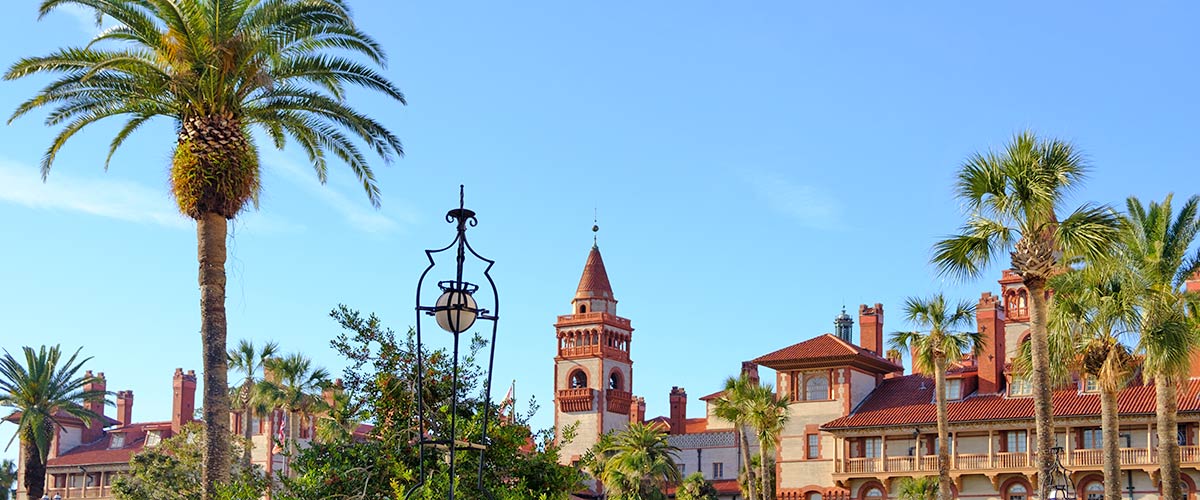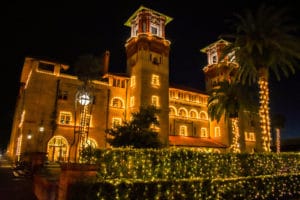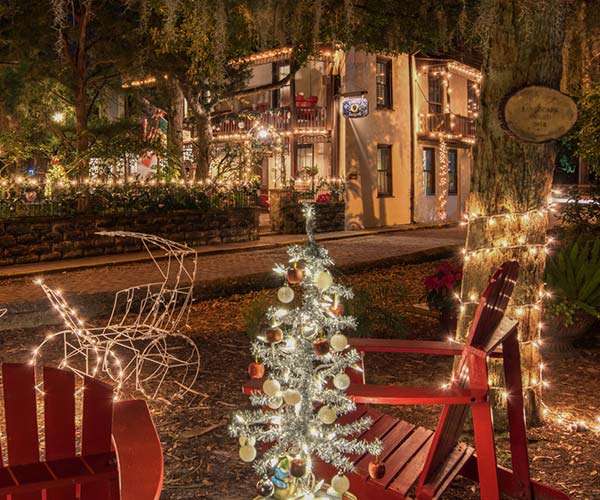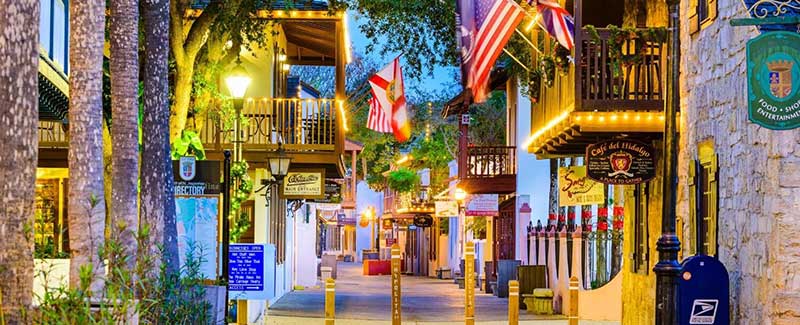
Historic Churches in St. Augustine, Florida
St Augustine is America’s oldest city, and thus dates back centuries and holds some deeply rooted history in the heart of the Old City. One of our favorite pieces of St. Augustine’s history is the churches, many of which were founded by the city’s earliest settlers. Just stepping into these historic buildings brings forth a sense of awe and wonderment. It also helps to understand and frame St. Augustine’s history, which was dramatically shaped by the establishment of these churches.
Here, we’ve listed five of our favorite historic churches. Come explore these beautiful and historic churches with us next time you stay at the St. Francis Inn in St. Augustine.
Cathedral Basilica of St. Augustine
Of all the historic churches in St. Augustine, this one is probably the most spectacular. Located on the central plaza, the Cathedral Basilica of St. Augustine is home to the oldest parish of a permanent European settlement in the country. The Cathedral Parish dates to the founding of St. Augustine in 1565, when the Spanish settlers celebrated a Mass upon coming ashore.
The first of the churches built for this parish was recorded as having been built at the southeastern corner of today’s Plaza. Over the years, battles and fires required the parish to be housed in different locations around the city. In 1786 the Spanish crown ordered the construction of a new parish church. The cornerstone was laid in 1793 and the church of the Immaculate Conception opened in August 1797.
The Diocese of St. Augustine was established in 1870, and the parish church was elevated to the level of a Cathedral. In 1887 the Moorish-style building was burned when a fire spread from the nearby St. Augustine Hotel. Through a national appeal for funds, the Cathedral was able to be restored, enlarged and reopened in 1888. The bell tower was also built and added grandeur to the architecture.
The Cathedral remained much the same architecturally as the city approached 1965, the 400th anniversary of the founding of St. Augustine. A major renovation was commissioned as the Diocese’s contribution to the quadricentennial. A Blessed Sacrament Chapel was added, as well as murals of Florida’s Catholic history by artist Hugo Ohlms, and a new tabernacle. In 1976, Pope Paul VI designated the church as a Minor Basilica, the 27th of all American churches to be honored as such. The Cathedral Basilica is also a National Historic Landmark.
Today “America’s FIrst Parish” continues over 450 years of history in the United States, offering Mass and parish activities to residents and visitors. The Cathedral Basilica of St. Augustine is located at 38 Cathedral Place, St. Augustine FL. There is a Gift Shop of religious items located in the Bell Tower.
Memorial Presbyterian Church
The sanctuary of Memorial Presbyterian Church was given by Henry Flagler, dedicated in 1890 as a memorial to his eldest daughter Jenny Louise Benedict, who died at a young age from complications during childbirth. Flagler is entombed in the church, along with his first wife Mary, Jenny Louise, and granddaughter Marjorie.
Flagler was the son of a Presbyterian minister, and donated the church, the land, and the former parsonage to the existing First Presbyterian Church Congregation of St. Augustine, in exchange for their former properties at the corner of St. George and Hypolita Streets, where Flagler had the 1890 Municipal Building erected for the city. The columns that stand at the church entrances were built from blocks taken from the walls of the old First Presbyterian Church which had been built from 1825-30.
This church is, to this date, one of the most intact churches in St. Augustine. It looks much as it did when it was first constructed from the designs of noted architects Carrere and Hastings. Historically, Memorial Presbyterian is one of several pioneer large concrete buildings that Flagler constructed in St. Augustine. It was built in the Venetian Renaissance Revival style, and elements of its architecture echo St. Mark’s Basilica in Venice. Features include a copper dome, pointed arches and elaborate decorative details in brick and terra cotta.
The church’s interior is laid out in the shape of a Latin Cross, with the major axis running North/South. The circular Flagler Family Tomb projects from the west side. The floor is Siena tile laid in Venetian pattern, with twelve plaques of violet broccia marble symbolic of the twelve apostles.
The Baptismal Font is solid Siena marble, with fine Italian carving. The carved eagle lectern is above the font, with a carved choir screen above and behind the rostrum. The pews, paneling, and doors are finely carved mahogany from Santo Domingo. The stained glass windows were a gift of Mr. Flagler in 1902 and represent articles of the Apostles’ Creed. The rose window in the west end is a symbol of God the Father Almighty.
In 2012, CNN designated Memorial Presbyterian Church as one of the “8 religious wonders to see in the U.S.” The church is an active Presbyterian congregation, and visitors are invited to worship. Major organ concerts are also presented at the church. Located at 36 Sevilla Street, St. Augustine, FL.
Mission Nombre de Dios
This park features a giant steel cross commemorating the 1565 landing of Pedro Menendez de Aviles and the history of the Mission Nombre de Dios, which later moved to this site. It was on these grounds that Father Francisco López de Mendoza Grajales, chaplain of Pedro Menendez’s expedition, presented a cross to Menendez, celebrated the first parish Mass and began the work at America’s first mission.
The Great Cross rises 208 ft. above the marshes of the Matanzas River. On the grounds are a historic cemetery, commemorative stone shrine, the site of one of St. Augustine’s later forts, and walking paths providing beautiful views of the bay, marshes and original settlement site. The Mission Nombre de Dios grounds and Gift Shop are open to visitors daily at no cost. Located at 27 Ocean Ave St. Augustine, FL.
Trinity Episcopal Church
Fronting on the central Plaza in St. Augustine’s Old City district, the original historic Trinity Episcopal Church was constructed from 1830-31 and rebuilt in 1902. It is the oldest of the Protestant churches in Florida.
The original church, constructed of local coquina stone, was 36 feet wide by 50 feet long. Three stained glass windows were added in 1857, the first of 29 stained glass windows installed in the church over 150 years. The windows at Trinity Episcopal depict many great biblical figures and events. Ten of the windows were made in Munich, Germany. One window is signed by Louis Tiffany Window, and others were created by noted stained and painted glassmakers. Several were funded as thank offerings and as memorials to loved ones and rectors.
Companion windows, depicting Evangelists Matthew, Mark, Luke, and John, accent the original entrance on King Street, and are the only stained glass windows in the church which were designed to be viewed from the church’s exterior. A large circular rose window is in the nave above the St. George St. entrance, with a design of the Holy Spirit symbolized by a descending white dove; a copy of a window in St. Peter’s in Rome.
Plans were unveiled in the late 1800s to rebuild the church and parsonage on the site of the old church, preserving the original front of the church. The church had become too small and was in poor condition. Reconstruction of the church took place after a six-year period of obtaining plans and raising funds.
First services were held in the “new” church in January 1903. The main entrance to the church had been re-oriented to St. George Street, and a neo-gothic style was used for a cruciform layout. The church capacity was increased to 500 worshipers. By the 1960s, the number of parishioners had again grown considerably. A parish hall, kitchen, classrooms, administrative offices, cloistered walkways, and other new facilities were added, complementing the neo-gothic architectural features of the historic church building. The church is located 215 St. George Street, St. Augustine FL.
St. Photios Orthodox National Shrine
The final building on our list of historic churches to see is the St. Photios Orthodox Shrine. The shrine was dedicated to the first colony of Greek people who came to Florida in 1768, ad it exhibits the life of early Greeks in America, along with the the development of the Greek Orthodox Church in America.
St. Photios Chapel is magnificent, with Byzantine style religious frescoes of the life of Christ, painted directly on the walls and domes, vibrating with abundant use of 22 karat gold leaf. Historic exhibits include artifacts, photographs and historical documents of the First Greek Colony in the New World.
Located in the historic Avero House, on the National Register of Historic Places, which is where 291 colonists seeking refuge from the demise of the New Smyrna plantation colony gathered in 1777. The English, who governed St. Augustine at the time, offered this Spanish house as a place for solace, prayer, and fellowship to the colonists. These pioneers were the first permanent settlement of Greeks on the continent.
Open daily 9:00 am-5:00 pm, except for major holidays. Located at 41 St. George St., St. Augustine, FL.







